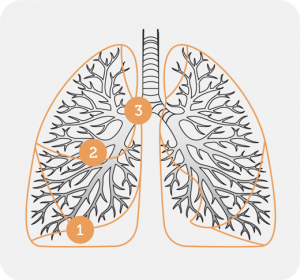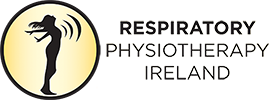Autogenic Drainage (AD), is an airway clearance technique that uses controlled breathing and minimal coughing to clear secretions from your chest.
It uses breathing at different lung volumes to gently loosen, mobilise and move secretions in three phases towards the larger central airways. (fig.1)
It involves you hearing and feeling your secretions as you breathe out and controlling the urge to cough until secretions are high up and easily cleared with little effort.
It is designed to avoid excessive coughing, airway irritation and wheezing that sometimes occurs when trying to clear sputum.
Your Respiratory physiotherapist can teach you how to control your breaths.
 Fig 1. 1 – small peripheral airways 2 – medium airways 3 – large central airways
Fig 1. 1 – small peripheral airways 2 – medium airways 3 – large central airways
The autogenic drainage technique consists of 3 phases:
Phase 1: Un-sticking secretions – mobilises peripheral secretions in the small airways at the bottom of the lungs by breathing at low lung volumes.
Technique: Breathe as much air out of your lungs as you can and then take a small breath in. Try resist any desire to cough.
Phase 2: Collecting secretions – gathers the secretions moving the mucus from the small airways to the medium-sized airways.
Technique: Medium sized breaths in and out. You may hear the crackles in your chest getting louder and more in the middle of your chest.
Phase 3: Evacuating Secretions – moves secretions from the medium-sized airways to the large central airways to be coughed out.
Technique: Full breaths in to your absolute maximum and then slowly sigh out.
Gentle active huffs then used to remove the secretions from the lungs through the mouth. These are carried out by imagining you are steaming up the mirror, and are as effective but less painful and tiring than coughing. Cough only if a huff did not move the secretions to the mouth.
At all stages, try to suppress the urge to cough until the sputum is in the central airways and ready to be expectorated.
Frequency and Duration
Your respiratory physiotherapist will advise you on how many cycles of AD to perform and how often you should perform this airway clearance technique. The duration and number of AD sessions depends on the individuals amount of secretions. You may be encouraged to continue until the lungs are clear.
Benefits of Autogenic Drainage
- No equipment required
- Patients can perform their airway clearance independently once taught the correct technique
- Autogenic Drainage is a very gentle technique so you should not start to feel tight or wheezy
- Less effort is required to expectorate which reduces stress on the pelvic floor
- Using these exercises will help clear lungs effectively without tiring you as it minimises the amount of coughing required
- Helps remove excess secretions from the lungs which minimises the risk of developing a chest infection
- Maximises expiratory airflow, keeping the airways open which means secretions are more easily removed
- Clearing secretions will improve lung function which also helps improve exercise tolerance/fitness levels
- Can be performed in various position and your respiratory physiotherapist will advise you on the best position for you.
Other things which may help
- If using a prescribed bronchodilator/inhaler, take the medication before performing these exercises as instructed by your physiotherapist
- Your physiotherapist will advise you if your nebulizied medication is to be inhaled prior to or during the AD session or after the lungs have been cleared.
- Patients with moderate to large qualities of secretions would benefit from at least two sessions a day or as advised by your physiotherapist.
- Always have a glass of water to hand that you can sip during these exercise.
